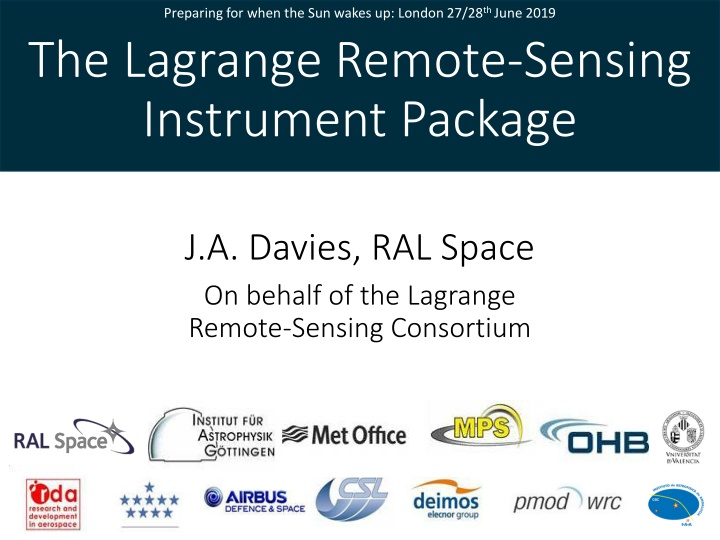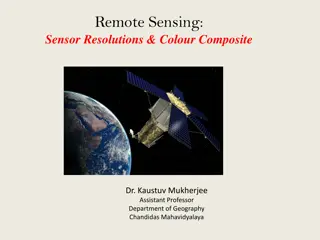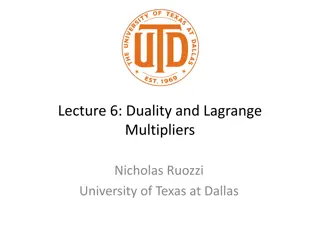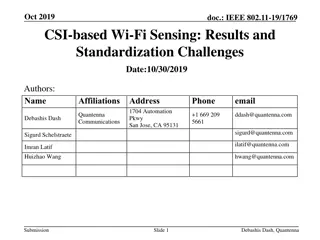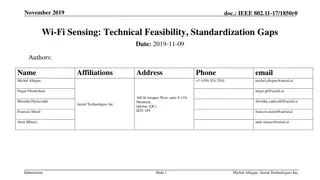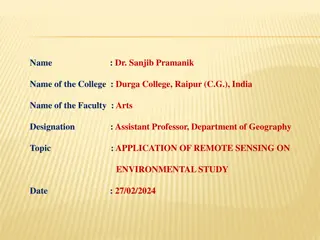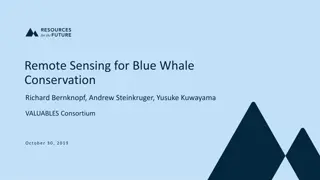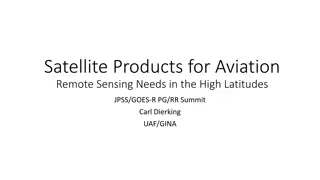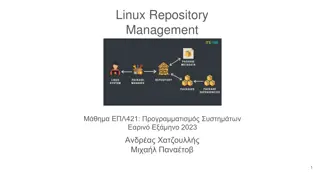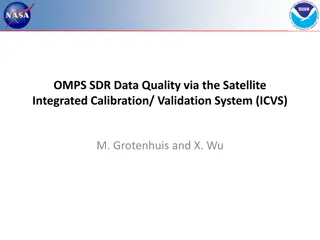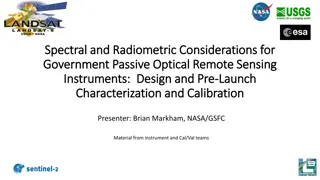Lagrange Remote-Sensing Instrument Package Overview
The Lagrange Remote-Sensing Instrument Package comprises four instruments for monitoring solar activity, including the Photospheric Magnetic Field Imager (PMI) and Extreme-UltraViolet Imager (EUVI). Consortium members from six nations are involved in this initiative, aimed at enhancing space weather monitoring and forecasting capabilities. The PMI tracks magnetic activity on the Sun, aiding in operational forecasts of Coronal Mass Ejections (CMEs) and visible-light continuum monitoring. The EUVI observes evolving solar phenomena such as prominences, active regions, and flares.
Download Presentation

Please find below an Image/Link to download the presentation.
The content on the website is provided AS IS for your information and personal use only. It may not be sold, licensed, or shared on other websites without obtaining consent from the author.If you encounter any issues during the download, it is possible that the publisher has removed the file from their server.
You are allowed to download the files provided on this website for personal or commercial use, subject to the condition that they are used lawfully. All files are the property of their respective owners.
The content on the website is provided AS IS for your information and personal use only. It may not be sold, licensed, or shared on other websites without obtaining consent from the author.
E N D
Presentation Transcript
Preparing for when the Sun wakes up: London 27/28th June 2019 The Lagrange Remote-Sensing Instrument Package J.A. Davies, RAL Space On behalf of the Lagrange Remote-Sensing Consortium
Consortium Members Phase A/B1 Study/Pre-developments for the Lagrange remote-Sensing Instrument Package includes consortium members from six nations: Belgium [CSL, ROB] Germany [ADS, MPS, OHB, UGOE] Romania [DMR] Spain [IAA, UV] Switzerland [PMOD, RDA] UK [DMU, RAL, UKMO]
Overview Four instruments: Photospheric Magnetic Field Imager (PMI) Extreme-UltraViolet Imager (EUVI) CORonagraph (COR) Heliospheric Imager (HI) with a common data handling unit*: Instrument Processing and Control Unit (IPCU) + End-to-End instrument performance Simulator (E2ES) + Space weather service provider oversight *For PMI, some of the data processing and control functions are handled by a dedicated electronics box
Photospheric Magnetic Field Imager (PMI) Monitoring magnetic activity on the Sun (basis for ambient solar wind for most operational CME arrival forecasts); monitoring visible-light continuum (sunspot activity/complexity/evolution) L5 enables observation of an additional 60 of the solar disk yet to rotate into view from Earth (longer lead-time monitoring/ improved ambient solar wind) Instrument lead: MPS Instrument support: IAA, OHB & UV
Photospheric Magnetic Field Imager (PMI) Concept: Concept: Modified version of the High- Resolution Telescope (HRT) of Polarimetric and Helioseismic Imager (PHI) on Solar Orbiter Observational specifications: Observational specifications: Products: vector magnetograms (B, , ); line- of-sight velocities (VLOS); continuum mapping (IC) Field of view: full disk + alignment margin Spatial resolution: 2 arcsec (for 1 arcmin APE) Cadence: 30 minutes I IC C V VLOS LOS B
Extreme-UltraViolet Imager (EUVI) Monitoring evolving activity in the near-Sun atmosphere including prominences (an early signature of CME eruption), active regions, coronal holes and flares L5 enables observation of an additional 60 of the solar disk yet to rotate into view from Earth corresponding to a potential 4 days of additional time warning of prospective Earth-directed events Instrument lead: CSL, ROB Instrument support: PMOD
Extreme-UltraViolet Imager (EUVI) Concept: Concept: Modified version of the Sun Watcher with Active pixel system detector and imager Processing (SWAP) instrument on the PROBA2 mission Observational specifications: Observational specifications: Product: EUV images at 19.5 nm (Fe XII) Field of view: 42.6 x 61.3 arcmin (extended towards Earth to 2.7 Rs) Spatial resolution: 3.2 arcsec Cadence: 2 minutes
CORonagraph (COR) Visible-light coronagraph imagery enables early CME detection and tracking (provides the basis of CME parameterization for most operational CME arrival forecasts) L5 provides clear side-on view of Earth-directed CMEs for more accurate arrival speed/time determination, especially when combined with corresponding near-Earth imagery Instrument lead: RAL Instrument support: UGOE
CORonagraph (COR) Concept: Concept: Modified version of the Solar CORonagraph for Operations (SCOPE) instrument being studied under ESA s GSTP programme Observational specifications: Observational specifications: Product: broad-band visible-light images Field of view (radial): 2.7 - 25 RS Field of view (position angle): 360 Spatial resolution: 1.6 arcmin Cadence: 5 minutes
Heliospheric Imager (HI) C:\Users\jad41\Desktop\20160302_080901_24h1A_br01_bkg.png Visible-light heliospheric imager monitors the vast, under-sampled region of space between the outer corona and Earth-like distances L5 provides clear side-on view of Earth-directed CMEs to mitigate deficiencies in modelling based on near-Sun observations alone through, for example, mid-course correction. Also gives information on the background solar wind Instrument lead: RAL Instrument support: UGOE
Heliospheric Imager (HI) Concept: Concept: Modified version of the twin- camera HI instruments on NASA s twin- spacecraft STEREO mission Observational specifications: Observational specifications: Field of view (radial): 4 - 70 elongation HI-1: 4 - 34 HI-2: 20 - 70 Field of view (position angle): >60 Spatial resolution: HI-1: 3.5 arcmin HI-2: 5.9 arcmin Cadence: 30 minutes (both cameras)
Combined Field of View Earth : 60deg elong n Not to scale Downlinked image sizes
Instrument Control and Processing Unit (IPCU) Provides control(*), commanding and telemetry power interface from spacecraft digital processing* mechanism control thermal control* (*except for PMI) Design based on five modules, three based on MetOp-SG heritage (Generic) solutions (GIM, GPM, GPCM) and two application-specific (Custom) modules (CIM and CPM) IPCU lead: ADS
End-to-End Instrument Performance Simulator (E2ES) E2ES supports definition of instrument/ IPCU, flight operations and ground segment. Built on the standard Space Science E2ES Reference Architecture, tailored to required high-level architecture, and modules defined. Instrument data simulator Ground processor prototype Performance assessment module Prototyped for HI; to be extended to the other instruments E2ES lead: DMU E2ES support: DMR, RDA
Progress/Status Where relevant, the instrument/IPCU/E2ES teams have: Developed designs generally compliant to the observational/ mission requirements; Undertaken optical, mechanical, thermal, electrical and performance analyses for those designs; Started critical pre-developments activities; Developed plans for future mission phases (e.g. model philosophy, AIT plans, on-board/on-ground processing strategies, calibration plans, PA plans); Developed a schedule, and a cost envelope both compatible with current scenarios for implementation.
Preparing for when the Sun wakes up: London 27/28th June 2019 The Lagrange Remote-Sensing Instrument Package The Lagrange Remote-Sensing Instrument Package Thank you
